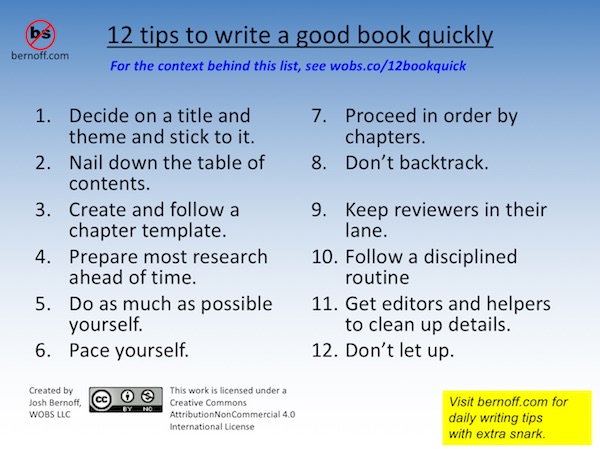How to write a good book quickly: 12 simple rules
 Can you write a good book in two or three months?
Can you write a good book in two or three months?
Maybe. But it takes planning and discipline.
I’ve done it, and so have other authors I know. Many of us feel that we created our best work quickly. I wrote most of Groundswell in 11 weeks and Writing Without Bullshit in three months, and both are buttoned-down, solid, effective work.
Don’t get confused. If you set out to write fast without knowing what you’re doing, the result will be crap. It’s like running a marathon — it’s over quickly, but the results depend on having the right equipment, the right skills, and the right planning.
So if you want to try this, follow the rules below. These rules apply to nonfiction books, and specifically to the process of creating a full, excellent first draft that’s nearly ready to publish. (If you write fiction, this might help you, but I make no guarantees because I have no useful experience with fiction writing at any speed.)
1. Decide the title and theme and stick to it.
What is the book about? Well ahead of writing, get this settled. Before you actually begin writing, write a “treatment” that includes the title, subtitle, and a description of the book that might appear on the front flap of the book jacket. Get feedback from others on the treatment until you’re totally sold on it. The title and theme become your North Star, guiding everything you write.
2. Nail down the table of contents.
You cannot write quickly unless you know where the pieces fit. Settle the list of chapters and once you have begun writing, do not deviate from it. Ironically, even if the chapters you write turn out to have organizational issues, you’ll find it easier to fix them if you’ve written the whole set. (I once reorganized the content for a whole book in one day; that was only possible because I’d followed a disciplined table of contents in creating the flawed draft.)
3. Create and follow a chapter template.
For example, your chapter template might read like this:
- Opening story
- Lessons learned
- Survey results
- Case study
- More lessons learned
- Summary of main points
Once you’ve written one of those chapters, writing ten more will be much easier. But if each of the chapters has its own idiosyncratic organization, writing them will be much harder.
4. Prepare most of the research ahead of time.
If you interrupt yourself constantly to track things down — or worse yet, if some key interviews and pieces of content are missing — you’ll never make it. You can write a chapter quickly if all the pieces you need are in place, thrown into a fat outline.
5. Do as much as possible yourself.
Communication carries overhead. It’s counterintuitive, but because of the need to communicate, two writers working together on a book will typically take more time than a single author. The same goes for outsourcing bits and pieces to other people. It’s a big job to write a whole book yourself, but you won’t waste time on communication with other contributors and managing the project; you can just make the decisions yourself. If you must collaborate, do so with a disciplined process and a collaborator who’s as committed to the quality and deadlines as you are.
6. Pace yourself.
You don’t win the marathon by sprinting out of the gate and then running out of steam on the third mile. Do the math. If you need to write 12 chapters in 12 weeks, determine the tasks and time necessary to write a chapter a week, and stick to it. Take a few breaks every day; normal writers can’t write good stuff for five hours in a row.
7. Proceed in order by chapters.
You can’t write a whole book quickly by writing a little of each chapter here and there, then stitching it together. If you can, write Chapter 1, then Chapter 2, and so on in sequence. This makes it easier to reference ideas from earlier chapters in later chapters and to keep the story you’re telling straight.
8. Don’t backtrack.
If you figure out in Chapter 3 that something is wrong in Chapter 2, don’t go back and fix it. Make a note and move on. As you write, you’ll develop new terms and themes. Make a note and keep going forward. If you keep tweaking earlier chapters, you’ll never get to the end. Go back after you’ve completed the draft and repair the things that needed fixing.
9. Keep reviewers in their lane.
If you work for a company, there will be many looky-loos hoping to see what you’re working on. Keep them at bay. Reviewers are fine, but they can destroy your flow. You might have one editor who reads everything as you create it and makes notes, and a technical expert who reviews specific sections, and the company’s CEO who reads the whole thing when the draft is done. These types of organized processes, determined up front, won’t derail you. Random reviewers parachuting in to take shots at you work will.
10. Follow a disciplined routine.
For example, sit down first thing, review research, write for two hours, take break, write for four more hours, review emails and comments on previous drafts, rewrite work from previous drafts, stop. Your process may be different. But you need a routine to free you from the decision of how to spend your writing days, preferably one that minimizes distractions. If you can’t get the time to follow a routine like this — if your day to day responsibilities will interfere — you’re unlikely to succeed.
11. Get editors and helpers to clean up the details.
You’re the writer. Your job is to write. If you can get others to help with non-writing tasks, that can speed things up. For example, you may hire or tap others to track down Web references, follow up with interviewees, or copy edit for grammatical errors. The communication with folks like this should be formalized and simple, because their jobs don’t interfere with with your writing. Somebody whose job is to question the table of contents or the theme halfway through is not a helper, nor is a boss who requests status reports at random intervals.
12. Don’t let up.
 Here’s what you can’t do: procrastinate at the start of the process and finish everything in a rush at the end. If you fall behind, you’re sunk. Create micro-deadlines — today I will write the case study for Chapter 3; this week I will complete the draft of all of Chapter 3. My technique on Groundswell was what I call “The Bear” — wake up each morning and imagine that a bear is chasing you, and if you slow down, he will catch you.
Here’s what you can’t do: procrastinate at the start of the process and finish everything in a rush at the end. If you fall behind, you’re sunk. Create micro-deadlines — today I will write the case study for Chapter 3; this week I will complete the draft of all of Chapter 3. My technique on Groundswell was what I call “The Bear” — wake up each morning and imagine that a bear is chasing you, and if you slow down, he will catch you.
This is one way to write. It’s not the only way.
This writing technique will create a good book quickly provided you can settle important prerequisites, like the theme and the table of contents, ahead of time. It also depends on your ability to set up the research ahead of time and minimize meddling reviewers. And of course, it depends on your being a fast writer to begin with.
Some books take many months or even years to assemble. That’s a fine way to go as well, and it will keep your blood pressure a little lower.
But if you have to write a book quickly, these tips will help you keep the quality high and the stress manageable.